Featured Exhibits
Sign up for the Newsletter
Advertise on ParachuteHistory.com
Disclaimer
Privacy Policy
About
Voyager Personal Emergency System
From December 14 to 23, 1986, Burt Rutan's Voyager experimental aircraft flew around the world on a single tank of fuel. Dick Rutan and Jeana Yeager were onboard.Individual contributions and equipment donations funded the five-year project. There were no federal funds.
In preparation for this journey, every contingency was considered including the possibility of termination the flight. The flight might be stopped by a major aircraft structural failure with occupants bailing out, or they might have to ditch in the ocean.
The task was to build very small and lightweight emergency systems. A parachute system was custom made by Butler Parachute Systems, Inc. then located in Ridgecrest, CA and then California City, CA. The survival equipment was selected from readily available items. All of the work by Butler was done pro-bono.
The structural weight of Voyager was a mere 939 pounds. Fully loaded with all equipment, fuel and crew it weighted 9,694.5 pounds. Incredibly only thirty-two pounds were the parachute and survival equipment for both Rutan and Yeager.
Initial Test Flights
Several test flights over the Mojave Desert were flown prior to the historic around the world flight. These flights were short and the crew did not have to switch positions. Rutan was able to wear a conventional pilot emergency rig. Yeager used a custom made back parachute. These parachute systems would not work for the extended flight. They could not change positions while wearing the gear.
In November 1985, Manley Butler met with the team and determined the parachute system requirements:
- Minimum weight and volume
- Personal floatation device (vest)
- Life raft
- Survival items
These were further refined to:
- Custom-fit, step-in torso harness with no adjustment hardware, to be worn throughout the flight
- Quick attach chest pack with parachute, life raft, floatation and survival gear integrated into the same package This would make bailout and ditching procedures the same and reduce clutter in the aircraft
- Parachute canopies sized to the user to minimize weight and bulk. This would give both of the crew approximately equal rates of descent
Yeager's parachute system was developed first and aided ongoing testing.
Butler developed the systems via several iterative steps. He had constant contact with the users and mission requirements.
Parachute Equipment
The parachute canopies were FAA approved Phantom 22 foot and 26 foot conical canopies. Ron Edwards, President of National Parachute Industries, donated the canopies.
FAA approved, also known as TSOd, equipment was desirable because of the short development time available.
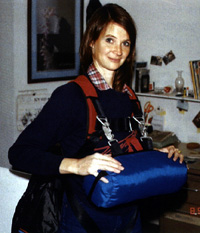 The harness measurements were done in mid-November. Butler delivered the first version of Yeager's parachute system ten days later. The canopy was something off Butler's shelf, since the National canopies had not arrived.
The harness measurements were done in mid-November. Butler delivered the first version of Yeager's parachute system ten days later. The canopy was something off Butler's shelf, since the National canopies had not arrived.
The risers were attached to V-rings on the harness with quick ejector snaps. On later versions the snaps were modified to allow easier release on water entry.
The pack was a simple tube with an opening on one side. It was closed with Velcro. A small loop of webbing was pulled to open the pack. The webbing was attached to the base of a pilot chute. This was similar to today's pullout deployment systems. The pilot chute was thrown at arm's reach into the airstream. The canopy was pulled from the pack. The pack was also used as a pillow when the crew was resting.
 The canopies arrived in April and were integrated into the parachute systems without the survival equipment. The container was held shut by a plastic coated stainless steel cable running through nylon loops. The loops passed through the container and helped maintain its shape. The extra tension also kept the canopies compressed. The red handled ripcord was located on the front of the pack. The webbing was also attached to the base of the pilot chute. This ripcord had a long stroke before the end of the cable cleared the closing loop. This was desirable to reduce the chance of accident opening while the crew moved about Voyager's tiny cabin.
The canopies arrived in April and were integrated into the parachute systems without the survival equipment. The container was held shut by a plastic coated stainless steel cable running through nylon loops. The loops passed through the container and helped maintain its shape. The extra tension also kept the canopies compressed. The red handled ripcord was located on the front of the pack. The webbing was also attached to the base of the pilot chute. This ripcord had a long stroke before the end of the cable cleared the closing loop. This was desirable to reduce the chance of accident opening while the crew moved about Voyager's tiny cabin.
These packs were worn on the closed course record flight in July. The weight of both of these systems was a mere 15 pounds. Rutan's container was 16" x 8" x 3". Yeager's container was 12" x 8" x 3".
Flotation Equipment
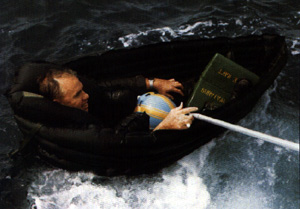
Rutan originally wanted to use a single one-man USAF life raft for both crewmembers. This was not practical if they had to bailout over an open ocean. The Miniboat was selected instead. Yeager and Rutan each had a MiniBoat inside the survival compartment. The raft was attached to the survival compartment with a 20-foot lanyard.
Each person also had a personal flotation device. The Eastern Aero marine model HC-2 was modified slightly. This device was primarily for helicopter passengers. The device had two flotation chambers. Theses were separated and one chamber was used per person. Obviously, the reduced weight also meant reduced flotation capability of the device.
The vest was stored in a pouch on the back side of the parachute pack. After the canopy was open, the user would pull the vest handle, pull it over his head and then inflate it. The inflated vest interfered with the user's ability to release the risers. Proper training minimized this problem.
Integrated Parachute and Survival System
The next version of the system included a compartment for the survival equipment. The lower half of the pack had the survival equipment. Each item was secured separately to the pack. A belly band was routed to the harness and snugged tight prior to bailout. The belly band was the only attachment of the survival gear to each user. The parachute had quick ejector snaps for easy jettisoning once in water.
Yeager's pack measured 12" x 11" x 4".
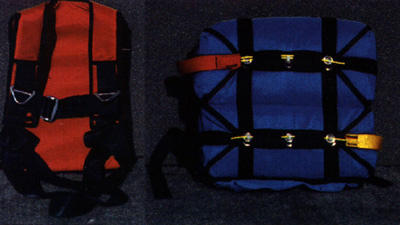
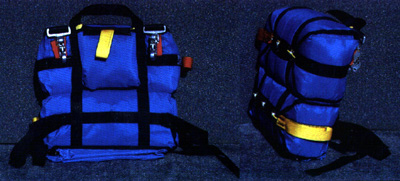
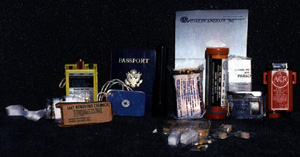
Rutan's pack measured 12" x 13" x 4". His pack had little plastic balls on the handle to distinguish it from Yeager's.
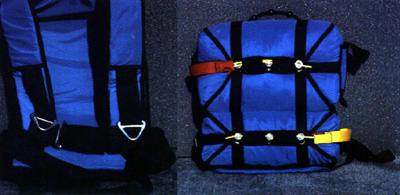
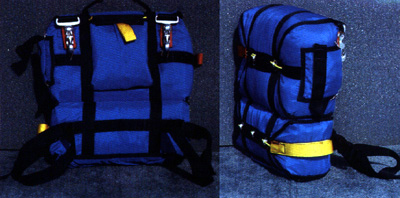
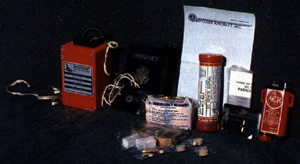
Complete System Specifications
| Parachute Equipment | Rutan | Yeager |
| Canopy with links | 5.804 lb. | 4.033 lb. |
| Harness | 1.381 | 1.209 |
| Risers | 0.778 | 0.771 |
| Cross Connectors | 0.095 | 0.095 |
| Container | 0.938 | 0.828 |
| Ripcord & Pilot Chute | 0.176 | 0.181 |
| Subtotal | 9.172 | 7.117 |
| Flotation Equipment | ||
| Raft w/o cylinder | 3.60 | 3.67 |
| Raft Cylinder (CO2) | 0.48 | 0.50 |
| Vest w/o cylinder | 0.41 | 0.41 |
| Vest Cylinder | 0.13 | 0.13 |
| Raft Handle w/ lanyard | 0.11 | 0.11 |
| Subtotal | 4.73 | 4.81 |
| Survival Equipment | ||
| Satellite transponder | 3.60 | - |
| Emergency Locator Transponder | - | 0.74 |
| Strobe Light | 0.44 | 0.46 |
| Mk 13 day/night flares | 0.41 | 0.42 |
| Pen gun flare set | 0.39 | 0.43 |
| Signal Mirror | 0.12 | 0.12 |
| Survival Knife/Tool | 0.09 | 0.09 |
| Flashlight | 0.20 | 0.20 |
| Survival Booklet | 0.03 | 0.03 |
| Subtotal | 3.85 | 2.48 |
| Total Weight (lb) | 17.76 | 14.41 |
| Total for Both Systems | 32.17 lb. | |
One of a Kind
The parachute and survival system used on the historic Voyager flight was the smallest and lightest system of its kind. Only the harness and pack were custom made. All other items were readily available.
 Voyager is on display at the Smithsonian. The parachute systems were last known to be in the possession of Jeana Yeager.
Voyager is on display at the Smithsonian. The parachute systems were last known to be in the possession of Jeana Yeager.
[Products] | [Services]
[Join Our Mailing List] | [Advertise on ParachuteHistory.com]
[ ]
[Disclaimer] | [Privacy Policy] | [About]